Why Does some Meat and Fish Contain Carbon Monoxide and Nitrites?
Key Words:
|
|
What is oxygen and why does it turn blood red?
Oxygen is a nonmetallic element constituting 21 percent of the atmosphere by volume. Oxygen is also found in many compounds such as water and iron ore. It combines with most elements, is essential for plant and animal respiration, and is required for nearly all combustion. Oxygen bind to the heme component of the proteins hemoglobin and myoglobin. When oxygen is bound to these proteins blood turns a bright red color.
What is carbon monoxide and why is it used in foods?
Carbon monoxide (chemical formula CO) is a colorless, odorless, flammable and highly toxic gas. It is a major product of the incomplete combustion of carbon and carbon-containing compounds.
Carbon monoxide binds hemoglobin in much the same way that oxygen does, only 200x stronger. In fact CO will displace oxygen from hemoglobin (or myoglobin) because it has such great affinity for hemoglobin. It is a known fact that carbon monoxide is used in processed meats and fish to keep the color of blood red for long periods of time. This keeps the meat looking fresh red for a long time.
Note: Oxygen and Carbon monoxide are not the only molecules to bind hemoglobin (or myoglobin). Nitric Oxide also does the same thing. Nitric Oxide can be formed from Nitrates. Nitrites are the reason cured meat is pink or red. Nitrites turn into Nitric Oxide, which reacts with the oxygen-binding proteins in the meat. Without the nitrites the cured meat would turn brown quickly.
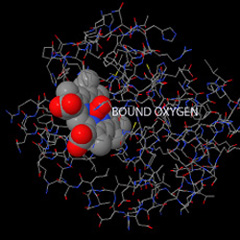 |
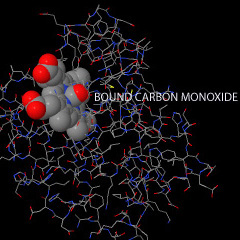 |
|
(Above)
oxygen bound to heme in myoglobin |
(Above)
carbon monoxide bound to heme in myoglobin -- CO
binds 200x stronger to the heme than O2 |
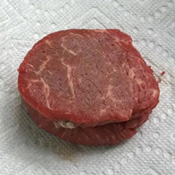 |
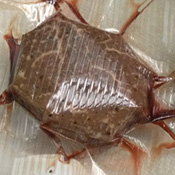 |
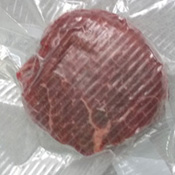 |
| a fresh piece of grass fed (unprocessed) piece meat will appear red from bound oxygen | when the same piece undergoes vacuum sealing, air (oxygen) is drawn out and the meat turns brown. | this cheap cut of meat interestingly retained it's red color even when vacuum sealed -- only the term minimally processed was included on the package. |
Browning of meat
There are many reasons that meat can turn brown. Cooking meat at a high temperature browns meat because of the maillard reaction. As meat ages it turns brown from oxidation. The oxidation process is a result of the bound iron molecule in myoglobin going from the ferrous to ferric form. This produces what is called metmyoglobin. Metmyoglobin is the cause of the characteristic brown coloration of meat that occurs as it ages.
References and Selected Readings:
Why Food Browns -- The Maillard Reaction
Science of Cooking
Why is Humidity Important in Cooking
What is the Maillard Reaction?
How is heat transferred during cooking?
What are the effects of the Maillard Reaction during cooking?